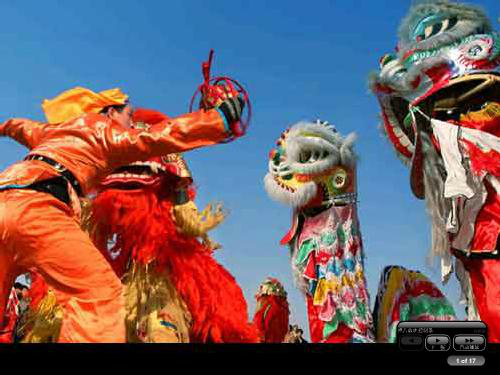Lion Dance

Year:2006
Sort:Folk dance
Area:Hebei, Shanxi, Zhejiang and Guangdong provinces
Serial No.:Ⅲ-5
The Lion Dance is one of the most widespread folk dances in China. The lion is the king of animals. In Chinese tradition, the lion is regarded as a mascot, which can bring good luck. The dance has a recorded history of more than 2,000 years. During the Tang Dynasty (618-907), the Lion Dance was already introduced into the royal family of the dynasty.
In the dance usually two people act as a lion: one waving the lion head and the other waving the lion body and tail; or one performer acts as a cub, while the other holds a silk ball to play with it. They dance in tempo to the musical melody.
Ancient people regarded the lion as a symbol of braveness and strength, which could drive away evil and protect humans and livestock. Therefore, performing the lion dance at theLantern Festival and other festive occasions became a custom where people could pray for good luck, safety, and happiness.
I Types by Style
The performance is divided into Wenshi (civilian lion) and Wushi (martial lion) according to the performing styles. Wenshi depicts docile and funny images of a lion. It scratches or licks itself, or dozes off. In some areas, the person playing the lion wears a mask. For instance, there are the Luohan (Arhat) Playing with the Lion in Sichuan and Hunan provinces and the Laughing Monk Playing with Lion in Shaanxi Province.
Wushi portrays the power of the lion. Besides the usual jumping, falling and tumbling, performers also show their excellent techniques by climbing up on a high table or by stepping on five wooden stakes. For instance, the Gaotai (High Terrace) Lion Dance of Sichuan Provinceis performed on seven high tables, which makes the performance highly difficult.
II Types by Geography
During the more than 2,000 years of development, the lion dance has developed into two major genres - the Northern Lion Dance and the Southern Lion Dance.
1.Northern Lion Dance
The Northern Lion Dance has a longer history than any other forms of lion dance. In theNorthern Wei Dynasty (386-534), Emperor Wudi launched an expedition to Hexi in Gansu Province, and took more than 100,000 Mongols captive. The emperor ordered the Mongols to perform dances and other entertainment. More than 30 Mongolian warriors held carved wooden animal heads, two big and five small, and wore animal skins, dancing before the emperor. The emperor was very pleased and named it the Northern Wei Auspicious Lion, and allowed the captives to return home. Then the lion dance became popular in northern China, and the Northern Lion Dance came into being.
The Northern Lion Dance mainly focuses on the performance of a martial lion dance. The dance of a small lion is performed by one person, and the dance of a big lion is played by two people, with one wielding the lion head while standing, and the other wielding the lion body and tail while stooping down. Guided by the lion dancers, the lion writhes, falls forward, jumps and bows, as well as some other highly difficult movements, such as walking on wooden or bamboo stakes, jumping over a table, and stepping on a rolling ball.
2. Southern Lion Dance
There are several legends about the Southern Lion Dance in China. One of the legends has it that in the Qing Dynasty (1644-1911), Emperor Qianlong dreamed about an auspicious animal in colorful hair on his inspection tour south of the lower reaches of the Yangtze River. After his return to Beijing, the capital, the emperor ordered his men to make one according to the image of the auspicious animal he dreamed about. He ordered some people to perform whenever there was a festival or a ceremony, in an effort to make the state prosperous and the people peaceful.
The Southern Lion Dance mainly focuses on the performance of the civilian lion dance. The performance pays a lot of attention to movements like scratching an itch, shaking the hair and licking the hair.
I Xushui Lion Dance
Declarer: Xushui County, Hebei Province
Hebei is the birthplace of the Northern Lion Dance. The Xushui Lion Dance is mainly performed during the Spring Festival and religious ceremonies of local temples. In the dance two people usually play the lion: one waving the lion head and the other waving the lion body and tail; or one performer acts as a cub, while the other holds a silk ball to play with it. The latter is one important feature of the Northern Lion Dance. The lion, with its exaggerated appearance, is mighty and valorous, and also naive and lovely. It can vividly perform watching, standing, walking, running, rolling, sleeping and shaking its maneand also many other difficultacrobatics.
II Tianta Lion Dance
Declarer: Xiangfen County, Shanxi Province
The Tianta (Heavenly Tower) Lion Dance formed during the Sui and Tang period (581-907), is surprising, adventurous, vagarious, peerless and splendid, since it is performed on towering hathpaces, which is really a breathtaking acrobatic scene. The protection and salvation of the Tianta Lion Dance is very important for research on local aesthetics, folklore, music and dance history.
III Huangsha Lion Dance
Declarer: Linhai City, Zhejiang Province
The Huangsha Lion Dance originated in the Northern Song Dynasty (960-1127) and was popular in the Huashayang area of Linhai City. Its biggest highlight is the ingenious adoption of martial arts into the performance. From the last day of the lunar year to the 2nd day of the 2nd lunar month of the next year, the lion dance is the hottest entertainment in every village, which reflects the locals' hopes for favorable weather, a bumper harvest, prosperous business, and auspiciousness and safety in the New Year. The Huangsha Lion Dance, valuable for research on local folklore, sociology, and aesthetics, now needs urgent protection and salvation. There are less than ten people alive who can perform the dance today.
IV Guangdong Lion Dance
Declarer: Foshan City, Suixi County, and Guangzhou City, in Guangdong Province
The Guangdong Lion Dance is a typical Southern Lion Dance. It originated from the royal lion dance during the Tang Dynasty (618-907) and was later introduced to the south by immigrants from the north. The Guangdong Lion Dance finally came into being in its present form that adopted local characteristics during the Ming Dynasty (1368-1644). It mainly focuses on the performance of the civilian lion dance, attaching much attention to movements like scratching an itch, shaking the mane and licking the hair.
The Guangdong Lion Dance, a combination of martial arts, dance and music, is popular not only in Guangdong and Guangxi provinces, but also among the overseas Chinese in Southeast Asian countries, making it a cultural bridge for overseas Chinese who are seeking their national roots.



